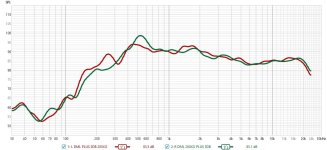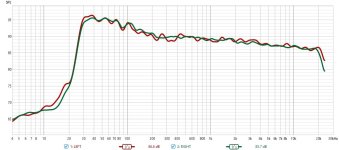This is the best I can do I'm afraid. The crossover was set to a 4th order Butterworth high pass filter @ 200hz. In theory the response should only have been 3db down @ 200hz. However, as you can see, it's much lower than this. My method of attaching the panel to the frame may be partly to blame.Can you please share how low your 60x40 cm panels play before they start to roll off (from the average level above say 100 Hz. or so)? Thank you.
Attachments
@homeswinghome
Hi Christian.
I've given the panels with the exciter not attached to a spine a more serious workout. It's definitely an improvement, to the point that I'm probably not going to bother with EPS. Response curve follows RTINGS to with 1db from 20hz to 20khz.
Simon.
Hi Christian.
I've given the panels with the exciter not attached to a spine a more serious workout. It's definitely an improvement, to the point that I'm probably not going to bother with EPS. Response curve follows RTINGS to with 1db from 20hz to 20khz.
Simon.
Attachments
Since my very beginning with DML, the bass roll off has been a mystery. We are getting now interesting information from the simulation. The first output of the simulation is the FR of the panel as it is mounted in a window of a giant wall that prevents the rear wave to interact with the front (half space). In such conditions, the FR extend to the lowest mode. In practice we see a roll off higher in frequency. The hypothesis is the front and rear waves cancellation like in an open baffle so in first approach linked to the dimensions of the panel compared to the sound speed in the air. A DML is much complex than a classical open baffle as the location of the source change with the frequency (anti-node location due to the mode shapes).Can you please share how low your 60x40 cm panels play before they start to roll off (from the average level above say 100 Hz. or so)? Thank you.
Christian

